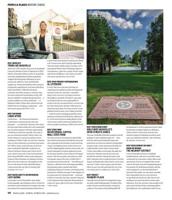At Summer Lights a few weeks ago, veteran African-American country singer J.J. Jones found a group of soldiers from Fort Campbell whooping and hollering through the Black Country Music Showcase. Their attention was fixated on Tammi Dee, a young singer from Houston with Barbie-doll looks, who led a procession of line dancers on the outdoor stage. Intrigued, Jones walked up to the goggle-eyed soldiers and asked them if they liked country music. Without peeling their eyes from Tammi Dee, they shouted, “We do now!”
Jones originally recorded with producer Pete Drake for ABC/Dot in the 1970s, when Charley Pride, O.B. McClinton, and Stoney Edwards were tearing through country music’s dotted color line. He thinks there was more going on at Summer Lights than just lovesick military men eyeing a pretty singer. “People are ready for new faces,” he says. “There’s a lot of talent out there Music Row hasn’t even heard.”
Jones and fellow country singer Frankie Staton have spent the past six months making sure that talent gets heard. In February, a showcase of African-American country singers at the Bluebird Café drew an overflow crowd of music writers, TV crews, songwriters, and even a couple of cautious industry types. “On Music Row, some people tell us it’s about time, some people tell us we’re crazy,” says Staton, a local club performer for the better part of two decades. “But in the black community, I know people are behind the effort.”
Momentum has only picked up since then. The success of the showcase brought a downpour of tapes from all over the country. “Everyone thought they were the only black artist in country music,” Staton jokes. Nevertheless, subsequent events such as the Summer Lights show have given Staton the exposure and leverage to request material from A-list Music Row songwriters.
This weekend, organizers Staton and Jones will launch the most ambitious, wide-ranging Black Country Music Showcase they’ve sponsored yet—a Friday-night show at industry hangout Caffé Milano in the waning days of Fan Fair. Cleve Francis, who released two Liberty LPs in the early 1990s, was so well-received at earlier showcases that he agreed to return as emcee.
Perhaps the most eagerly anticipated act is Wheels, a six-piece African-American country band from Lynette, Ala., whose road-tested live show Staton compares to a cross between the Temptations and Restless Heart. Among others, the bill also features Terry Lee Jones, “the bronze John Anderson” from Albany, Ga.; Cynthia Talley, a recently discovered honky-tonk singer from Dickson; and Kandi Lee, a young vocalist who learned her moves by studying Reba McEntire’s concert videos.
In recent months, the national press has noted the absence of African-American artists from contemporary country music—even as the Country Music Foundation readies a monumental boxed set of a century of black country performers. To see where that legacy is headed, show up for Friday night’s showcases at 7 and 9:30 p.m. Call 255-0073 for reservations.
As communities from Athens, Ga., to Beaumont, Texas, have shown, small towns often have music scenes that rival or best their big-city competitors. But a music scene doesn’t develop overnight, as Peter Cooper demonstrates in an entertaining new book entitled Hub City Musicmakers. Subtitled “One Southern Town’s Popular Music Legacy,” the book explores a century of music culture in Spartanburg, S.C., an unlikely hamlet that has nonetheless fostered such diverse notables as David Ball, Champ Hood, and the late Walter Hyatt of Uncle Walt’s Band; bluesmen Pink Anderson and Pegleg Pete; The Marshall Tucker Band; and Nashville club favorite Marshall Chapman.
Was there something in Spartanburg’s water? Indeed there may have been, Cooper says: An 81-year-old retired mill worker remembers seeing future guitar legend Hank Garland, then a boy, diving naked into the Pacolet River. “There were lots of mills in the area,” Cooper adds, “and in the mill villages people were always picking on their front porches. The town was steeped in music.” The author, who attended college in Spartanburg, traces the development of that influence through profiles of the town, its residents, and their collective contribution to pop music.
Some of Spartanburg’s fruit will appear at a book-release celebration this coming Wednesday night at the Sutler. On hand will be David Ball, Marshall Chapman, George McCorkle of the Marshall Tucker Band, and probably a few more homesick South Carolinians. The book is now available in local stores from Holocene Press. It’s worth seeking out.
A couple of weeks ago, the downtown YMCA kicked off what organizer Mike Brennan hopes will be an ongoing musical outreach program. Entitled “We Like Music,” the program enlists local musicians to meet and work with inner-city kids interested in learning about music. About 16 kids were selected to attend the day-long program on the basis of grades, achievement, and interest, and musical coordinator Jill Block got local performers to donate their time and share their knowledge. “These kids probably wouldn’t get a chance like this otherwise,” says Brennan. “We’re getting a lot of interest.”
Problem is, the Y desperately needs musical instruments and equipment to share with its young would-be musicians, who can ill afford the needed gear. If you’ve got an old guitar, amp, or other musical instrument or piece of equipment gathering dust in your garage—or sitting unused in your showroom—give Brennan a call at 254-0631. The kid you help today could be playing a Marshall stack tomorrow.
Songwriters Tony Arata (“The Dance”), Steve Jones (“Ten Thousand Angels”), Karen Taylor-Good (“How Can I Help You Say Goodbye”), Don Henry (“Where’ve You Been”), and Gary Burr (“What Mattered Most”) headline the Names Behind the Artists benefit for NSAI June 24 at the Bluebird Café. They’re among the featured performers on The Names Behind the Artists Vol. 1 & 2, two Silver Eagle Cross Country Records compilations of hit songs performed by the tunesmiths who wrote them. Listen for John Denver’s demo of “Leavin’ on a Jet Plane.”




